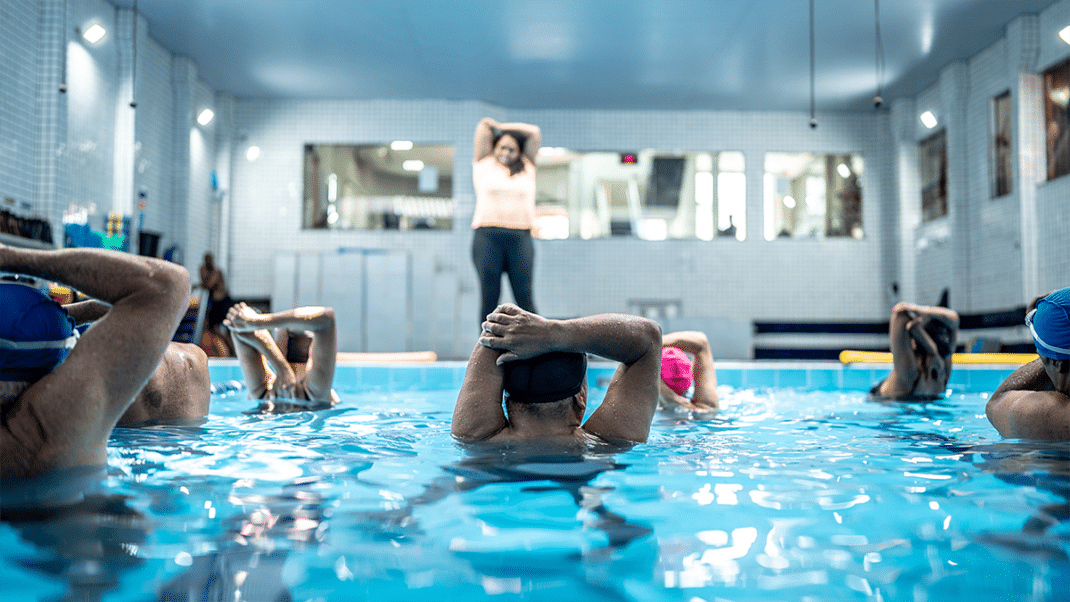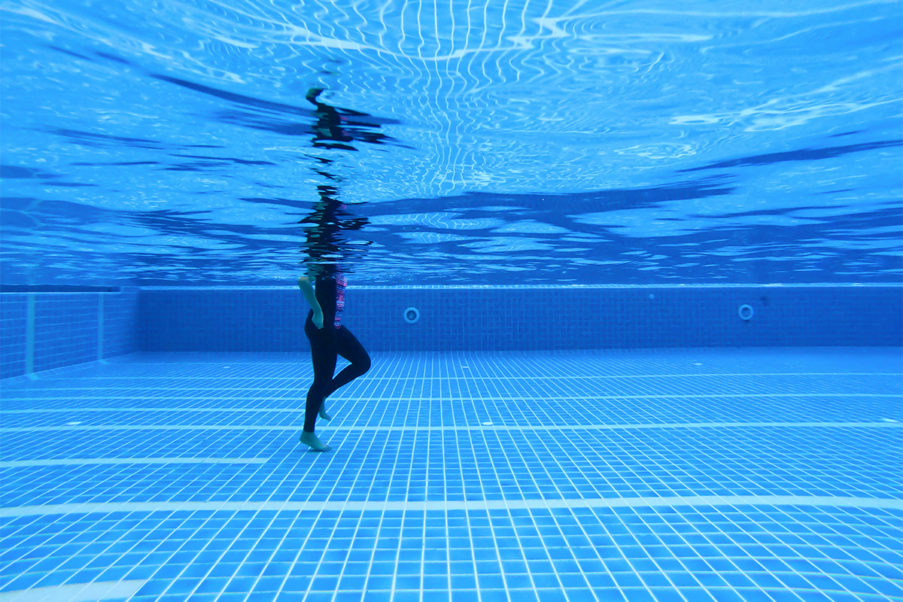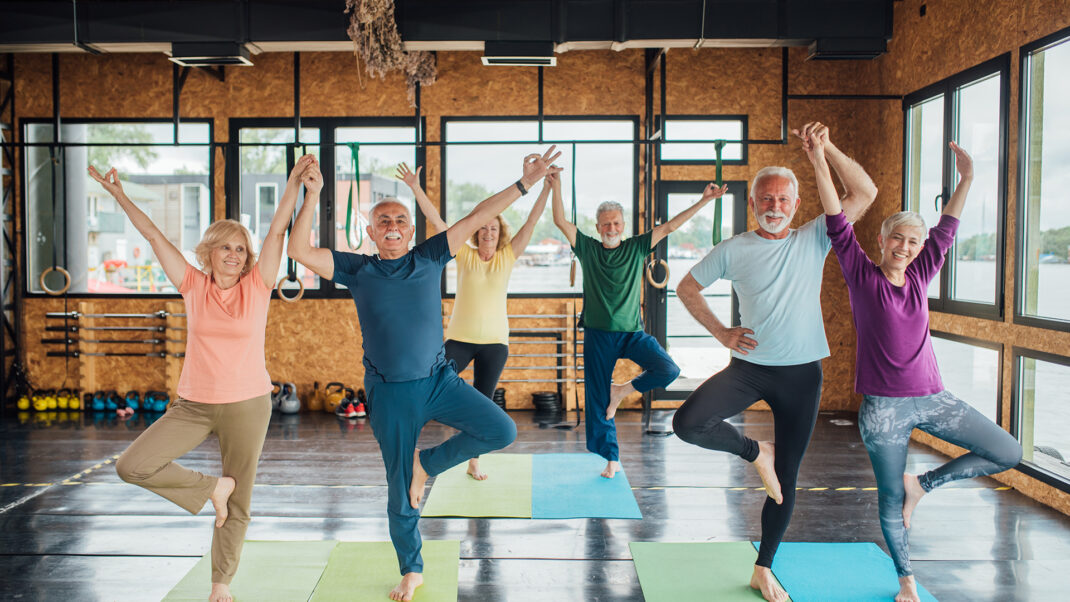Water Fitness: Pool Coaching vs. Deck Coaching
Pointers for both deck and pool coaching so you can give your participants the best water fitness experience.

Every water instructor has personal thoughts about the ideal place to lead a water fitness group: either in the water with the group, feeling what attendees are feeling, or on deck, mimicking how the members should move in the pool. Both deck and pool coaching have their pros and cons, and the way to be successful is to be comfortable and confident in whichever position you, as the instructor, choose.
For example, the best solution for you may be to instruct part of the session from the deck and part from the water. It’s truly about finding what works best for you and your attendees, and it doesn’t have to be the same for every session. Here, we’ll cover some pointers for both deck and pool coaching so you can give your participants the best water fitness experience.
Vantage Point
Coaching on deck gives your participants a much clearer line of sight than if you are in the pool, especially if your group is larger in number. However, that front row directly underneath you may find that they get a crick in the neck from looking up at you for 45 minutes to an hour.
Make sure to move from one end of the pool to the other, so attendees can experience different vantage points as well as relieve the constant pressure on their cervical vertebrae. If your pool is large enough and there are no structures such as slides that limit their peripheral view, move to the right and left corners of the pool so that participants aren’t always looking up but can track you from side to side. You can even turn the front row of the group into the back row by instructing a portion of the session from the opposite side of the pool if the logistics permit.
Change it up even more by instructing from each of the four sides of the pool so everyone gets a chance to be in the front and back rows! Moving from one position to the other periodically also gives you a chance to make eye contact and create a connection with more participants. After all, we know that creating a sincere connection keeps the members coming back week after week.
See also: Mindful Water Fitness in the Pool
Making Connections With Participants
Not to be outdone, one of the great benefits of coaching in the pool with your participants is the ability to make a deeper connection. If your group is small, you can move from person to person, correct technique, smile, greet them personally, motivate and congratulate. This is much more difficult from the deck.
However, the size of the group is a major determining factor as to whether instructing strictly in the pool will work for you and your members. Perhaps you could begin in the pool, move to instruct the bulk of the session on the deck and then jump back in at the end to motivate and congratulate.
Another point to consider is how many rookies versus veterans are present each week. If you have dedicated regulars and limited newbies, ask if you can join them by pool coaching to take the stress off your joints. They are probably familiar with your moves and your terminology, and, therefore, will still be successful even though they can’t see you as well. Just remember to focus the intensity on their capabilities and not let it turn into your workout.
Managing Equipment
If your pool equipment is on deck with your stereo and possible microphone, instructing on the poolside offers you easy access to change any audio volume, exchange equipment for a different size or add equipment to the workout.
Maybe a new participant bit off more than she expected and needs smaller buoys, perhaps a member is feeling strong and wants to add a pair of web gloves, or maybe a more muscular man needs a second noodle around his waist to stay afloat. Should you need to share a verbal technique cue with the entire group, you can easily turn the music down when on the deck. The sudden silence gets everyone’s attention during the session, even the social butterflies.
Just make sure that as you move around on the deck, you are careful of slippery areas and trip hazards such as the edge of nonslip mats, ADA compliant equipment and hoses or lifesaving devices. The same warning goes for when you are visually cuing the members to run backwards, and you are moving without being able to see what is behind you. On deck, you also have immediate access to that important water bottle and towel to wipe the sweat out of the eyes!
Visual Cuing
Visual cuing from the deck is obviously more effective than being in the water where most of your body is underneath the water’s surface. Remembering that the majority of adults are visual learners, it’s important to create a repertoire of cues that your members can identify with and that remain consistent.
If I want the group to perform a series of knee jogs, I alternately tap each knee in quick repetition right before I start the knee jog. But if I’m cueing tuck jumps, I hit both knees and then bring my hands up to my chest with spinal flexion, so it mimics a jump. These consistent cues let my members know what is coming next and also minimizes the number of times that I expose my joints to the impact of the cement deck.
For that same reason, I also create smaller combinations (i.e. 8 cross country skis into 8 tuck jumps) that they can do repeatedly, perhaps not turning the first couple of attempts and then simply adding a turn, cued by circling a finger over my head. This keeps choreography fresh and minimizes how much I stress my voice and my joints.
Safety While Cuing
Remember that most acute and chronic injuries occur on the deck while instructing, so limit the actual amount of impact that you put on your body. This small amount of caution becomes especially helpful if you are instructing multiple aqua sessions per week from the deck.
Also maximize the use of chairs, stools, group fitness step platforms and pool structures, such as ladders, for mimicking suspension moves. If your pool equipment is kept in outdoor gardening type containers, they are a great height to demonstrate suspended or repetitive jumping moments. If I want my participants to turn a frog jump, I utilize the end of a step platform on two or three risers so that I can actually turn with them as I mimic the frog jump.
Just make sure whatever you are sitting on is in good condition for your safety. Chairs and stools need to be sturdy and able to handle shifting body weight. Visually cuing a neutral combination of moves is always difficult, so I’ll slip my hands into my shoes and show the attendees how I want the bottoms of the feet just barely sliding across the pool bottom. If you want to take your shoes on and off, remember to tie them tightly when finished, or just throw an extra pair into your gym bag and leave your shoes safely on your feet!
Visual cuing may include pointing, to indicate the direction in which you want participants to turn or run, or holding up fingers for how many reps you want them to perform. Additionally, instructing a shallow water session means you have to be able to mimic the “loading down” of the knee joints for the rebounding effect. This is often a challenge for new instructors on the deck or for land instructors who are transitioning into water fitness. It is always beneficial to spend some time in front of a full-length mirror to practice the flexion of the knee joints while keeping the chest lifted so that you, the instructor, can present a quality visual of proper posture during rebounding moves. Former land instructors or instructors new to the pool environment tend to mimic moves that push off the cement against gravity, as opposed to loading down to oppose the buoyant environment of the pool.
If your club provides a microphone and the sound doesn’t echo, instructing with that mic is probably best done from the deck unless it is safely submergible. However, if you don’t have a mic, remember that coaching on deck allows the members a clear view to see your mouth and read your lips. Make it a bit easier by wearing a bright shade of lip gloss and using only key words. This is also helpful for members who may remove hearing aid devices before entering the pool. While most people are visual learners, we still need to cater to the auditory learners.
It’s All About Safety and Experience
While there seems to be more pros to instructing on deck than cons, it’s important to remember that safety comes first for everyone, including you, the exercise leader. On deck you are exposed to the trip and slip hazards mentioned above, as well as environmental concerns such as humidity, heat, dehydration and sunburn. Be aware of your environmental obstacles and always be prepared with sunscreen, water and a towel.
In conclusion, each group and each attendee has their own preference when it comes to deck and pool coaching. While we try to please everyone, the bottom line is the overall experience that we provide for the members.
See also: Water Workouts Make a Splash
Melissa Layne, MEd
Melissa Layne is an assistant professor of kinesiology at the University of North Georgia and the author of Water Exercise (Human Kinetics, 2015). She has over 35 years of experience in teaching water fitness and group exercise classes, certified by ACE and AEA.




